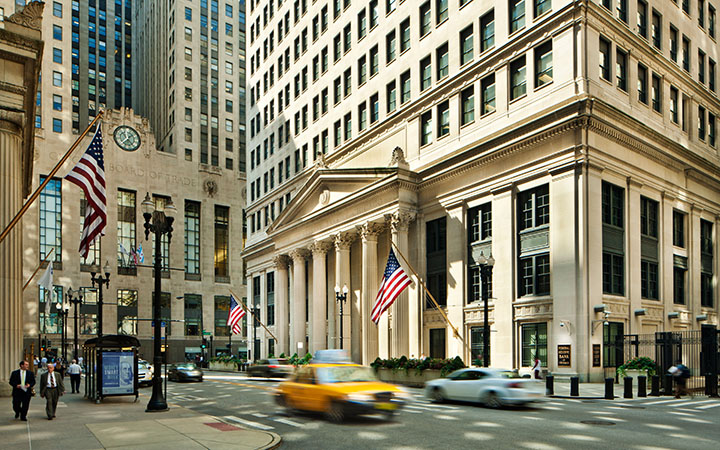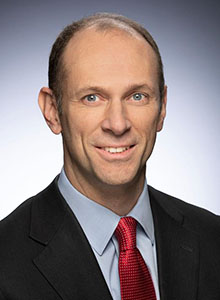Federal Reserve Bank of Chicago

The Chicago Fed is Born
After the Federal Reserve Act was approved on December 23, 1913, an organization committee assembled to determine the locations of the Reserve Banks. Both the Secretary of the Treasury and the Secretary of Agriculture attended the Chicago meeting held on January 19, 1914. As there was little doubt that the city would have a Reserve Bank, debate centered on the territory it would cover.
Presenting the case for Chicago bankers, James B. Forgan of the First National Bank of Chicago advocated putting all of Illinois, Indiana, Iowa, Michigan, and Wisconsin—and even parts of Nebraska, Minnesota and Ohio—in the Chicago Reserve district. Secretary of the Treasury William G. McAdoo, who earlier had listened to New York lay claim to nearly half of the country's banking resources, noted that there would be very little left for the other Fed Banks if New York and Chicago were accommodated.
The Committee requested correspondence from banks and businesses to determine their preferred Reserve District. Banks from Chicago to Bloomington, Indiana, to Sioux City, Iowa sent letters to name their location choice for their Reserve Bank. Polling showed Chicago had the support of 714 of 861 area banks. Chicago was named the seventh of twelve Reserve Banks, its territory including northern Illinois and Indiana, southern Wisconsin, all of Iowa and the lower peninsula of Michigan. Banks in 25 northern Wisconsin counties would later petition to be added to the Seventh District, a request granted by the Federal Reserve Board in 1916.
The Chicago Fed opened for business on Monday, November 16, 1914. James B. McDougal was selected as the Bank's first governor (a title changed to president in 1935). As head examiner for the Chicago Clearing House, McDougal was well known to Chicago bankers and the choice "was greeted with universal approval."1 Chicago Fed presidents have hailed from the worlds of business, banking, regulation and academia.
Moving Up and Out
Expanding from 41 employees on opening day to 1,200 by 1919, the Bank outgrew its office spaces—at the time scattered throughout the Loop in downtown Chicago. The Chicago Fed purchased a lot on LaSalle Street that extended from Quincy Street to Jackson Boulevard. The architectural firm of Graham, Anderson, Probst and White completed the Bank's landmark Beaux-Arts building in 1922.
Michigan bankers frustrated by business delays caused by travel time requested for a Branch of the Chicago Fed in Detroit. As the second largest industrial area in the Seventh District, Detroit was a logical candidate, and the Bank board of directors voted in November 1917 to establish the Branch.
When the U.S. joined World War I in 1917, the Reserve Banks were authorized to handle the financial operations through the sale of Liberty Bonds. After increasing personnel and office space to handle the campaign, the Chicago Fed sold $3.29 billion in bonds, the largest subscription per person across the Fed Districts.
Statistical information on business trends became increasingly available in the early 20th century, and the Chicago Fed pioneered the System's effort to sort and analyze the data. In 1918, the Bank established the Statistical and Analytical Department to compile statistical information and a "Business Reporting Service" to gather data from producers and merchants.
The Great Depression
After the stock market soured in 1929, the glum attitude was reflected in Chicago when a band marched up LaSalle Street to celebrate construction of the new Board of Trade Building. Many listeners "thought the band should have played a funeral dirge," according to the Chicago Tribune.2 Despite the Chicago Fed's Examination Department helping to reorganize hundreds of District banks, two dominant Detroit banks faced collapse in 1933.
Chicago Fed Governor McDougal, leading commercial bankers, U.S. Treasury officials, representatives of the Reconstruction Finance Corporation and others met to resolve the crisis, but no organization, public or private, was willing to provide the necessary loan. A statewide bank holiday declared by the governor of Michigan prompted an even greater currency drain on the Chicago Fed. Bank closings reached 4,000 in 1933, approximately 30 percent located in the hard-hit Seventh District. Despite New Deal efforts to stimulate spending, the downswing continued through the 1930s. It was not until preparations for World War II began that the Seventh District and the rest of the nation completely shook off the Depression.
Postwar Growth and Change
Though the Fed's monetary policy was centralized, Reserve Banks were responsible for measuring and evaluating economic trends in their district. Chicago Fed President Young began the practice of holding Board of Directors meetings' outside of Chicago in the 1940s. He frequently traveled to meet with farmers, bankers and business leaders, declaring, "The day is past when a banker can sit at his desk and read reports. We have to get out and know what is happening."3
The U.S. economy and Seventh District grew at a steady clip through most of the 1950s and early 1960s. In its 1955 annual report —entitled "Growth and Prosperity in Five Midwest Cities"—the Chicago Fed noted that the District states accounted for 19 percent of the nation's personal income, one-fourth of factory output and nearly one-fourth of farm income. However, redlining and de facto discriminatory policies in areas like employment and education excluded many residents from the region's prosperity.
In the postwar era, the Chicago Fed faced increasing pressure as the largest check processor in the Federal Reserve System. By 1956, the Bank was operating 24 hours a day to clear more than half a billion items annually with approximately 40 percent of the Bank's employees engaged in clearing checks. To increase efficiency, the Federal Reserve introduced automated processing at all 12 Reserve Banks in the 1960s.
The end of the 1960s also saw the beginning of the Federal Reserve's responsibility for consumer credit regulation. Combined with legislation from the 1930s, favorable economic conditions and the cautious attitudes of bankers, only one Seventh District member bank failed from 1941 to 1964. Interest rates continued to increase in the late 1960s, influenced in part by U.S. involvement in the Vietnam War. By the end of the decade, approximately 74 percent of Seventh District banks were paying the 4 percent maximum rate for savings deposits, according to a 1969 Chicago Fed survey.
In 1964, The Chicago Fed hosted its first conference, the Annual Conference on Bank Structure and Competition. It was a forum for academics, regulators and industry participants to debate current issues affecting the financial services industry.
Stagflation and Recovery
The 1970s provided little respite from the inflation problems that had built up in the late 1960s. Wage and price controls instituted in 1970 were, in the words of the Chicago Fed's monthly review, "judged unsatisfactory by virtually everyone." And 1974 was labeled a "year of calamity" by the Bank.
In 1979, the U.S. was jolted by the second oil price shock of the decade and experienced its worst inflation in the post-war period. Newly appointed FOMC Chairman Paul Volcker acted with a sharp increase in interest rates. The economic slowdown that resulted was particularly tough on the Midwest. Chicago Fed President Keehn noted "Despite strong gains in employment nationally, manufacturing jobs continue to decline and the agricultural sector remains extremely depressed." Agricultural banks, feeling the slump in the farm sector, were especially hard-hit and accounted for 32 percent of all bank failures nationally by 1984.
As the Midwest economy faltered, the Chicago Fed became involved in cooperative efforts to improve the long-run economic performance of the Seventh District. Working with various public and private groups, the Bank participated in numerous economic development projects including studies of the Great Lakes region, the states of Iowa and Wisconsin and the cities of Chicago and Detroit. The outlook for the Midwest finally brightened in 1987 when economic activity outpaced the rest of the nation for the first time since 1980.
In 1990, The Chicago Fed joined forces with the University of Illinois to establish the Regional Economic Applications Laboratory (REAL), a center for research on the changing nature of the District economy. The Chicago Fed also expanded its community outreach with the opening of a interactive lobby display explaining the Bank's role. The lobby display evolved into the "Money Museum" and other community outreach efforts such as "Money Smart Week," which launched in early 2000 and continue today.
Into the 21st Century
The Chicago Fed, along with the rest of the System, prepared its personnel and internal systems to handle the Y2K threat to automated processes throughout 1999. These emergency protocols would prove more useful two years later. After the terror attacks on the Pentagon and Lower Manhattan on September 11, 2001, The Fed quickly provided liquidity to a reeling global financial system. The Chicago Fed, one block from the Willis Tower, evacuated non-essential employees but remained in place for the duration of the crisis. Chicago employees worked long hours to assist customers and keep the discount window open until midnight for three days following 9/11.
In 2007 subprime mortgage lending disrupted the period of general macroeconomic stability known as the Great Moderation. With home prices decreasing and mortgage defaults increasing, the Fed provided liquidity to financial institutions facing collapse in the interest of stabilizing the national economy. The Fed also brought interest rates as low as effectively possible and began regular stress testing for depository institutions.
The Chicago Fed convened the Regional Home Ownership Preservation Initiative (RHOPI) with the Chicago Community Trust and NHS of Chicago. Individuals representing almost 100 organizations worked to reach recommendations and action steps late in 2008 to address the high rates of foreclosure and resulting vacant property in the metropolitan area. Recovery started slowly in June of 2009.
A Global Pandemic
On January 30, 2020, the World Health Organization (WHO) declared a Public Health Emergency of International Concern in response to the outbreak of Coronavirus Disease 2019 (Covid-19). The global economy experienced a worldwide market crash between February and April 2020, the worst in U.S. history. On March 11, 2020, the WHO declared Covid-19 a global pandemic, and the Chicago Fed instituted a mandatory work-from-home situation effective the following day. Despite the extraordinary conditions, Bank staff continued their day-to-day work in addition to conducting research and creating new initiatives to understand the stresses on communities, support economic recovery efforts, and to maintain financial services operations across the Fed's Seventh District.
Endnotes
- 1 F. Cyril James, 1938, The Growth of Chicago Banks, New York: Harper & Brothers Publishers.
- 2 Ibid.
- 3 Federal Reserve Bank of Chicago, 1942-1971, The Commentator, Chicago, Various Issues.
Written by the Federal Reserve Bank of Chicago, September 2021. See disclaimer and update policy.


 X
X  facebook
facebook
 email
email